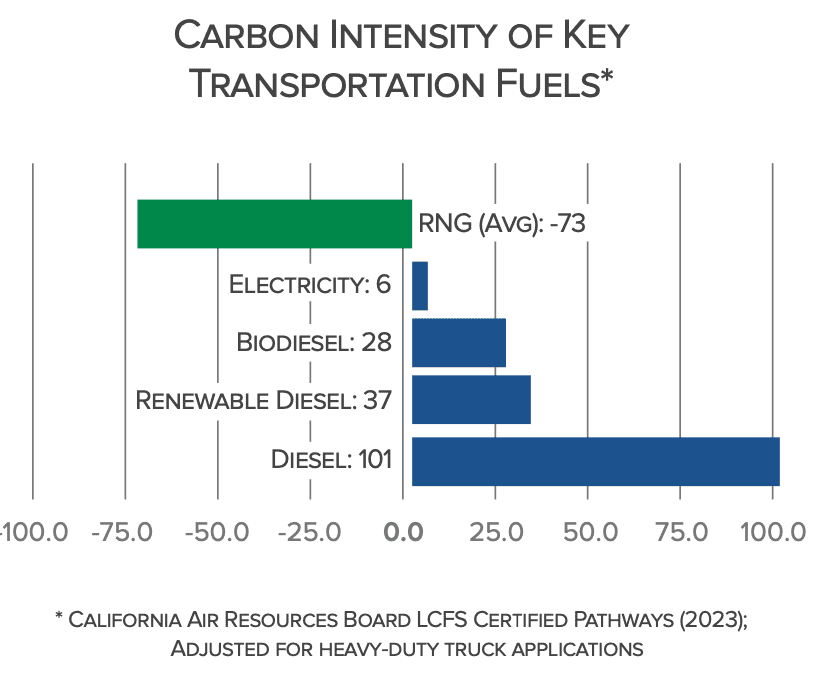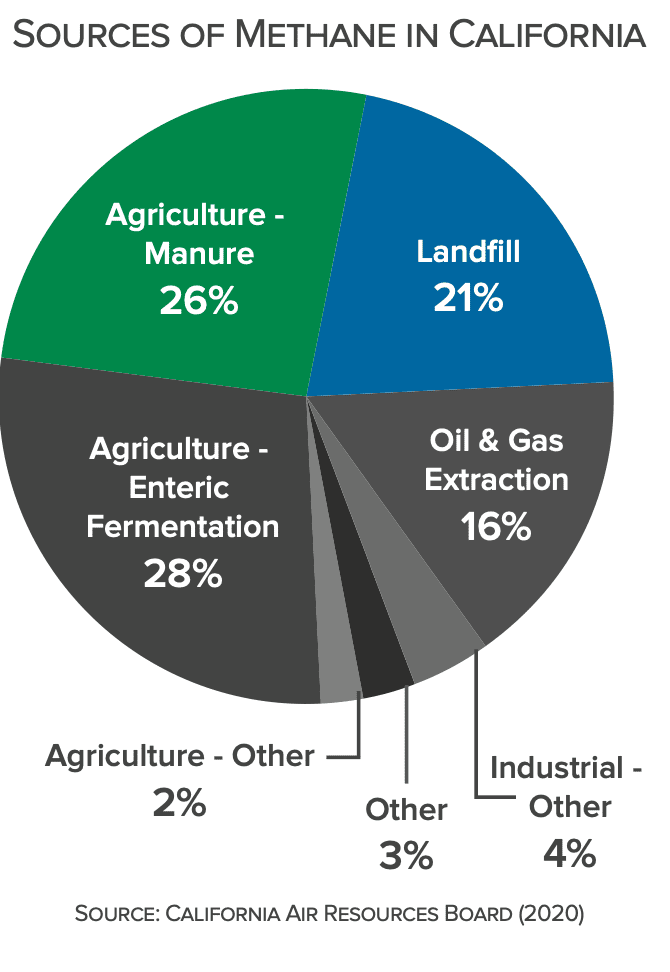Questions and answers to the most common myths related to natural gas vehicles (NGVs) and renewable natural gas (RNG).
Download a “Get The Facts” PDF
-
Is renewable natural gas a fossil fuel?
Renewable natural gas (RNG) is not a fossil fuel and is not produced by fracking.
Utilizing Organic Waste. RNG is made primarily from organic waste, generated by a variety of sustainable and renewable sources, including wastewater treatment plants, food and green waste, landfills, dairies, farms, and forest management. It can also be produced as a byproduct of renewable hydrogen and sequestered CO2, a key strategy to store surplus renewable electricity.
No New Carbon. Unlike fossil fuel, RNG is not formed by a geologic process and did not spend millions of years underground. RNG simply recycles carbon that is already present in the biosphere and does not add carbon to the atmosphere.
-
Is there enough RNG supply to support wide-scale deployment of medium- and heavy-duty natural gas vehicles (NGVs)?
As long as we have a productive society, we have the ability to capture and reuse methane emissions from organic waste at dairies, farms, wastewater treatment plants, and landfills and produce an ample supply of RNG in return.
Ample Supply. A 2019 ICF study found that by 2040 there will be up to 32 billion diesel gallons equivalent (DGE) of RNG supply available nationally. Total on-road diesel use currently falls at about 46 billion DGE annually, meaning RNG could replace nearly 70% of the US’ on-road diesel fuel use annually.
California’s Usage. More than 126 million Diesel Gallon Equivalent (DGE) of RNG was sold into the California transportation market in 2018, according to California Air Resources Board LCFS data. That means approximately 90% of the 160 million gallons of natural gas transportation fuel used in California is renewable, not fossil natural gas.
-
Is RNG “real,” or is it just a carbon accounting strategy?

RNG is tracked by the same accounting system as other forms of renewable energy including wind and solar, which is backed by research and verified by experts, agencies, and state governments. We cannot invalidate one form of renewable energy without invalidating all.
The Math Works. CARB’s assessment shows that RNG produced from dairy waste has one of the lowest carbon intensity (CI) rating of any transportation fuel. When made from renewable sources, natural gas for transportation can reduce greenhouse gas emissions up to 283%, with an average of 51% reduction (varies by feedstock). The average CI value for RNG produced in California will steadily improve over the next few years as more dairy digester projects come on-line.
A Verified System. To expedite adoption of low carbon fuels, California created a comprehensive, verified, state-wide system the Low Carbon Fuel Standard (LCFS)program. Since first implemented in 2011, low carbon fuel use is increasing and fuel producers in California are continuing to take action to decrease carbon intensity.
-
Will incentivizing RNG production encourage factory dairy farming?
Dairy digesters allow us to cost-effectively capture in-state methane emissions, enabling dairy farms—the majority of which are family-owned—to meet tightening emission regulations while helping to keep 180,000+ dairy related jobs in state.
Capturing Emissions at Scale. Livestock manure is the source of 26% of California’s methane emissions. Dairies face increasingly strict mandatory regulations such as SB1383 which requires dairy emissions to be 40% below 2013 levels by 2030. Dairy digester projects keep California’s dairy industry price-competitive and protect in-state jobs by enabling dairies to cost-effectively meet emissions regulations while creating viable revenue streams. Without this critical financial incentive in place, California’s dairy industry, and its 180,000 jobs, are at risk of leaving the state.
More Than Emission Capture. Tightly permitted anaerobic digester projects help protect local air, water, and soil quality by ensuring strict environmental requirements are met. In-state dairy digester projects provide revenue for farmers, and create opportunities for local jobs in contracting, construction, permitting, and engineering.
-
Can producing and using RNG help us protect the climate?

The immediate reduction of fugitive methane emissions—which can be achieved by producing RNG— is necessary to rapidly reduce the impacts of climate change.
Need to Effectively Address Main Sources. Methane has up to 87 times the global warming potential of C02 in the first twenty years after its release. Nearly 50% of methane emissions in California come from organic waste decomposing in landfills and livestock manure. Both sources of methane could be captured and converted into renewable natural gas for transportation, heat and power.
Opportunity to Maximize Co-Benefits. California has the opportunity to fund projects that enable the state to address multiple policy objectives while offering new revenue streams to businesses (e.g., capturing methane from dairy manure, converting it into renewable natural gas that can be sold as a transportation fuel, and providing revenue back to the dairy family to offset the costs of methane capture).
-
Is RNG expensive to produce and use?
Renewable fuels, including RNG, can actually generate revenue for producers and users.
Price Competitive. As an emission reduction strategy, the capture and beneficial reuse of biomethane are among the most cost-effective strategies to protect the climate. As the market matures, production volumes increase, and long-term contracts develop, the opportunities for further cost reduction for RNG are even more significant.
Scaling and Incentivizing Renewable Energy. At the state level, California has developed its own market-based system to financially incentivize, and ultimately scale, the production and use of low carbon and renewable fuels. Through California’s LCFS, producers and users of renewable fuel, including RNG, can cover the cost of their fuel and even generate additional revenue.
-
Are zero-emission battery-electric trucks cleaner than natural gas trucks?
A heavy-duty truck powered by a near-zero-emission natural gas engine has tailpipe NOx emissions that are comparable to – or lower than – the amount of NOx emitted to produce electricity used to charge a similar heavy-duty battery-electric truck.
Comparing Lifecyle Emissions. When determining total emissions, the full lifecycle of each energy source must be examined, not just the tailpipe emissions. Plug-in electric vehicles have NOx emissions associated with the electrical generators that supply power to the grid used to recharge them. Even in states with the cleanest electrical grids in the nation—California, Oregon, and Washington—NOx emission rates are 2.5 to 3.5 times higher than the near-zero emissions level of 0.02g/bhp-hr.
-
Is it expensive to own and operate a natural gas truck?
Natural gas trucks can have higher upfront capital costs, but lower operating costs give them an overall total cost of ownership comparable to diesel trucks.
Easier and Cheaper Than Diesel. Due to lower fuel and maintenance costs, NGVs over an 18-24 month payback period. On the maintenance side, natural gas trucks don’t require a diesel particulate filter (DPF), DPF regeneration or waste, selective catalytic reduction (SCR), or diesel emission fluid (DEF)—making them simpler and easier to maintain than diesel trucks.
Domestic and Price Stable. At the pump, average natural gas prices are typically $1 to $2.25 lower than diesel and much more stable. Economic models predict that this price spread will remain for several decades. Compared to charging an electric fleet, RNG is not subject to demand charges, time of use charges, or tariffs, and can be purchased on a fixed diesel gallon equivalent cost basis via long term contracts.
No One Technology Fits All. There is no “one size fits all” vehicle technology that will meet all of California’s emission reduction needs. California’s fleet operators—including transit, delivery, goods movement, schools, utilities, refuse, and more—have a diverse set of operating requirements and need a portfolio of affordable, low carbon, clean transportation solutions available.
-
Do natural gas trucks provide the power, range or reliability that fleet operators require?
Near-zero natural gas trucks are the closest direct replacement for diesel trucks in terms of operational performance.
Cleaner, More Efficient, Longer Lasting. When looking across factors including range, fueling frequency & fueling speed, driver comfort & safety, and maintenance support, natural gas vehicles hold up to diesel trucks better than any other commercially available vehicle technology.
Current natural gas engines offer comparable performance (horsepower and torque), reliability and engine life as their diesel or gasoline counterparts. Heavy-duty natural gas engines are rated for applications up to 80,000 pounds GVWR, and higher when properly configured. Additionally, natural gas vehicles can achieve up to 600+ miles of daily operation without compromise.
-
If natural gas vehicles have a similar total cost of ownership to diesel, do they still need incentives?
Incentives are needed for all clean vehicles that will help California rapidly and cost-effectively achieve air quality goals.
Incentives Get Us to Clean Air Faster. State incentives for natural gas vehicles help us reach near-term air quality and climate goals faster and more cost effectively than investing in any other currently available vehicle technology. The future of California’s transportation sector will require a diverse set of clean fuels and vehicle technologies to meet a diverse set of operational requirements. Heavily favoring one fuel type or vehicle technology, while removing incentives for other technologies, removes competition from the marketplace—decelerating innovation, performance improvements, and cost reduction.
Limited Funding Dollars. California does not have the means to fund the replacement of every medium- and heavy-duty vehicle in the state. Current funding available is not adequate to achieve improved air quality, National Ambient Air Quality Standards (NAAQS), and to immediately protect human health. Therefore, it is imperative that California spends its limited incentive dollars wisely, achieving the maximum amount of emission reductions for every dollar spent.
-
Are there adequate natural gas vehicle models and fueling stations to meet a fleets operating needs?
NGVs are commercially available from a wide variety of manufacturers in every vehicle application and fleets can refuel at natural gas stations across the nation.
Commercially Available and Road Tested. More than 50 vehicle manufacturers produce over 100 models of NGVs, with an established sales and service network. There are over 150,000 NGVs on U.S. roads today, operating across every sector and weight class, including medium- and heavy-duty trucks, buses, shuttles, and refuse. More than 23 million NGVs are currently in operation worldwide.
Established Fueling Infrastructure. There are more than 1,600 public CNG stations in the US, with more than 50 planned or under construction. More than 2.5 million miles of pipeline distributes natural gas from coast to coast. Fleet owners and operators have more access to natural gas fueling infrastructure than ever before.
-
Would we achieve more air quality benefit by waiting for zero tailpipe emission technology to be commercially viable versus investing in near zero natural gas trucks and buses now?

Californian’s want clean air NOW, and near-zero emission natural gas trucks can get us there.
Air Pollution Impacting Public Health. Although California leads the nation in setting aggressive and effective emissions standards for vehicles, more than 88% of Californians (35 million people) still live in areas that do not meet U.S EPA’s NAAQS. Heavy-duty diesel trucks are the largest source of harmful air pollution and emissions have been climbing in recent years.
Focus on Commercially Available Solutions. CARB has stated that achieving healthy air requires the immediate replacement of heavy-duty vehicles with ones that meet its lowest-tier optional low-NOx emission standard (0.02 g/bhp-hr NOx). Optimistic projections estimate zero-emission battery electric technology or hydrogen fuel cell electric vehicles will not be commercially available at scale before 2030. Natural gas trucks can help California immediately and cost-effectively reduce truck emissions today. In addition, building our renewable natural gas supply will accelerate the supply of renewable fuel to power zero-emission fuel cell vehicles when they become more commercially available in the future.









